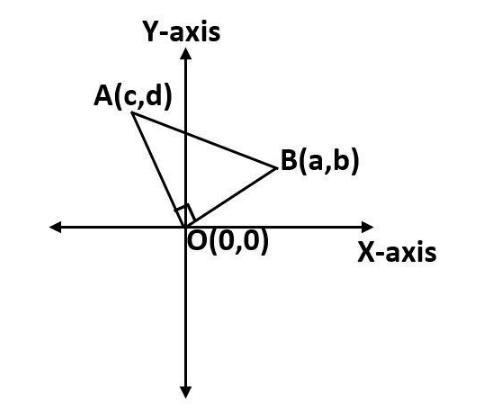
If the segment joining the points $ (a,b) $ , $ (c,d) $ subtends a right angle at the origin, then
(A) $ ac - bd = 0 $
(B) $ ac + bd = 0 $
(C) $ ab + cd = 0 $
(D) $ ab - cd = 0 $
Answer
556.8k+ views
Hint: Write the coordinate on the Cartesian plane and give them some name. Form a right angle triangle by joining those points with the origin. Then find all the sides of the triangle using distance formula. And then substitute them in the Pythagoras theorem to solve the question.
Complete step-by-step answer:
Observe the diagram

According to the question, $ (a,b),(c,d) $ subtend a right angle at the origin.
Now, observe the diagram and let us assume that A and B are the points which have the coordinates $ (c,d) $ and $ (a,b) $ respectively.
Then using distance formula, we can write
$ O{B^2} = {a^2} + {b^2} $
$ O{A^2} = {c^2} + {d^2} $
$ A{B^2} = {(a - c)^2} + {(b - d)^2} $
And by using Pythagoras theorem, we can write
$ A{B^2} = O{A^2} + O{B^2} $
By substituting the value of in the above equation, we get
$ {(a - c)^2} + {(b - d)^2} = {c^2} + {d^2} + {a^2} + {b^2} $
Now, by using the expansion formula of square, $ {(a - b)^2} = {a^2} + {b^2} - 2ab $ , we can expand the above equation as,
$ {a^2} + {c^2} - 2ac + {b^2} + {d^2} - 2bd = {c^2} + {d^2} + {a^2} + {b^2} $
By cancelling the common terms, we get
$ - 2ac - 2bd = 0 $
By taking common terms out, we get
$ - 2(ac + bd) = 0 $
$ \Rightarrow ac + bd = 0 $
Therefore, from the above explanation, the correct answer is, option (B) $ ac + bd = 0 $
So, the correct answer is “Option B”.
Note: Always draw a rough diagram. It helps to understand what approach should be taken to solve the question. Like in this question, it became easy to observe in the diagram that we can use the Pythagoras theorem as well as distance formula and then compare the two to find the answer.
Complete step-by-step answer:
Observe the diagram

According to the question, $ (a,b),(c,d) $ subtend a right angle at the origin.
Now, observe the diagram and let us assume that A and B are the points which have the coordinates $ (c,d) $ and $ (a,b) $ respectively.
Then using distance formula, we can write
$ O{B^2} = {a^2} + {b^2} $
$ O{A^2} = {c^2} + {d^2} $
$ A{B^2} = {(a - c)^2} + {(b - d)^2} $
And by using Pythagoras theorem, we can write
$ A{B^2} = O{A^2} + O{B^2} $
By substituting the value of in the above equation, we get
$ {(a - c)^2} + {(b - d)^2} = {c^2} + {d^2} + {a^2} + {b^2} $
Now, by using the expansion formula of square, $ {(a - b)^2} = {a^2} + {b^2} - 2ab $ , we can expand the above equation as,
$ {a^2} + {c^2} - 2ac + {b^2} + {d^2} - 2bd = {c^2} + {d^2} + {a^2} + {b^2} $
By cancelling the common terms, we get
$ - 2ac - 2bd = 0 $
By taking common terms out, we get
$ - 2(ac + bd) = 0 $
$ \Rightarrow ac + bd = 0 $
Therefore, from the above explanation, the correct answer is, option (B) $ ac + bd = 0 $
So, the correct answer is “Option B”.
Note: Always draw a rough diagram. It helps to understand what approach should be taken to solve the question. Like in this question, it became easy to observe in the diagram that we can use the Pythagoras theorem as well as distance formula and then compare the two to find the answer.
Recently Updated Pages
Why is there a time difference of about 5 hours between class 10 social science CBSE

In cricket, what is a "pink ball" primarily used for?

In cricket, what is the "new ball" phase?

In cricket, what is a "death over"?

What is the "Powerplay" in T20 cricket?

In cricket, what is a "super over"?

Trending doubts
What is meant by exothermic and endothermic reactions class 11 chemistry CBSE

Which animal has three hearts class 11 biology CBSE

10 examples of friction in our daily life

One Metric ton is equal to kg A 10000 B 1000 C 100 class 11 physics CBSE

1 Quintal is equal to a 110 kg b 10 kg c 100kg d 1000 class 11 physics CBSE

Difference Between Prokaryotic Cells and Eukaryotic Cells




